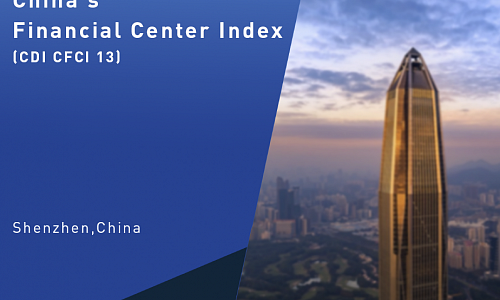Housing Supply and Demand in Big and Small Cities: Why the Difference?
Author: Fan Gang, President of CDI
Editor’s Note: The latest upsurge in land price and housing price revealed an important policy reason that it is the urbanization strategy that has caused polarization in cities. It is crucial to follow the law of population migration and urbanization to free up more land for the development in big cities.
 The latest upsurge in land price and housing price revealed an important policy reason that it is the urbanization strategy that has caused polarization in cities.
The latest upsurge in land price and housing price revealed an important policy reason that it is the urbanization strategy that has caused polarization in cities.
The basic rationale of urbanization is agglomeration. The greater the agglomeration is, the more advantages it brings. Township enterprises move into big cities because costs of roads and electricity in rural areas are pretty high. By contrast, building development zones in the vicinity of cities boasts a number of advantages including lower-cost infrastructure and more convenient logistics, thus more businesses can be supported with the same amount of investment. Industrial agglomeration creates jobs and income, and thus attracts people.
Large population in big cities generates jobs in the service sector. The service sector is an outcome resulting from socialization of family life. When family life is socialized, jobs are created. Population agglomeration can create new economies as well as new knowledge. According to the knowledge spillover theory in economics, the stock of knowledge, when pooled, can proportionally produce knowledge increment. The advent of excellent schools and hospitals as well as new forms of culture in big cities is precisely the result of population agglomeration.
China currently sets a limit on the population in big cities, which means the supply of public goods, including land, is not arranged in accordance with the anticipated population influx in the future. However, it is futile to set such limits to restrict migration, for the population in big cities will soon go beyond the set limit as long as people are willing to move in. This will give rise to polarization in cities, which refers to the disparity in population flow between big and small cities. On the one hand, the population influx in large cities causes a serious imbalance between supply and demand; on the other, population outflow from small cities and towns results in supply far outstripping demand. This indicates a flaw in the urbanization policy, which goes against the law of human migration, urbanization and industrialization.
With the country in an ongoing process of rapid industrialization, population keeps migrating into cities, and yet the retired population has not reached a considerable size. Therefore, small towns that are not located within big city clusters will be facing challenges and difficulties to develop at the present stage. Some of them will probably die out with the population outflow. Yet it’s just that the prime time for development has not come for most of these towns. As a matter of fact, population outflow is also a way of development, as it is conducive to the increase of per capita income in small towns. In addition, preservation of old houses, natural environment and distinctive culture in small towns could also prepare the towns for the backflow of retired population in the future.
It is crucial to follow the law of population migration and urbanization to free up more land for the development in big cities, including the surrounding small towns. Once population concentrates in big cities, tension between supply and demand will arise in housing, transportation, public security, social security, and other public services. To crack the problems, we should make massive further adjustments, which should no longer be limited to controlling housing prices by simply imposing a property purchase limit, but also levying property taxes, increasing urban floor area ratio, reforming rural land system, and adjusting the urbanization development strategy, etc. The underlying logic of the purchase limit should be to ensure that the limited supply of housing units goes to those who are in need, not to those who speculate in real estate. Property purchase limit is not an absolute necessity as property tax can be implemented instead. Property tax boasts inherent stability, which means the higher the housing price, the higher the tax. If the property tax is high enough, rather than less than one percent in trial cities like Shanghai and Chongqing, it will eventually come into play.
Indicators Signal Good Prospects
 Due to Chinese New Year, many statistics are still not available, making our analytical task more difficult. But one notable policy change is that monetary policy reversed its 2016 loosening trend, and shifted into tightening. We also expect this to be the trend for 2017. M1 rose 14.5% y/y, continuing the declining trend it began in August, decreasing 1 pps per month on average, and rising 20% y/y, after correcting for the New Year’s holiday effect. M2 rose 11.3% y/y, its lowest level since last year.
Due to Chinese New Year, many statistics are still not available, making our analytical task more difficult. But one notable policy change is that monetary policy reversed its 2016 loosening trend, and shifted into tightening. We also expect this to be the trend for 2017. M1 rose 14.5% y/y, continuing the declining trend it began in August, decreasing 1 pps per month on average, and rising 20% y/y, after correcting for the New Year’s holiday effect. M2 rose 11.3% y/y, its lowest level since last year.
Loan growth has hit a new low. Chinese yuan loans from financial institutions rose 12.6% y/y, down 2.7 pps from last January, and their lowest growth rate since June 2005. Deposits from non-financial enterprises rose 11% y/y, showing a deleveraging trend since November. Imports jumped 16.7% y/y, and were up 14 pps from Q4 2016 in January, Exports improved less, rising 7.9% y/y.
CPI rose 2.5% y/y in January or 2.3% y/y after correcting for the New Year’s effect, slightly higher than last month. Producer prices continued rising. PPI rose a rapid 6.9% y/y, and 0.8% m/m, up 1.4 pps from last December. We expect PPI to match its last peak of 7.5% y/y, seen in July 2011.
The CEEM-PMI (an abbreviation for the China External Environment Monitor PMI), an external PMI indicator recently developed by the China Academy of Social Sciences, measures China’s external economic environment. It recently rose to 53.6, above the 50 threshold, mostly in line with, but better than, the two general PMI indices, NBS PMI and HSBC PMI, which were at 51.3 and 51 respectively. While the latter two figures indicate a general economic recovery for China, the CEEM-PMI signals possible improvement of external demand. The jump of the CEEM-PMI may be mainly driven by developed markets. For example, the new high value of U.S. PMI at 56 may be interpreted as a rebound from the previous overreaction to Trump-driven trade uncertainties.
Facing the Trade Uncertainties
 GDP in 2016 rose 6.7% y/y, down 0.2 pps from 2015, reaching the lowest yearly level in China. The quarterly growth was highly stable, with first three quarters rising 6.7% and the fourth quarter rising 6.8%. In 2016, fixed asset investment rose 8.1%, down 1.9 pps from 2015. From the growth trend, it rose fastest in Q1, and grew 10.7% y/y, higher than Q3 and Q4 in 2015. The other three quarters displayed slower growth rates.
GDP in 2016 rose 6.7% y/y, down 0.2 pps from 2015, reaching the lowest yearly level in China. The quarterly growth was highly stable, with first three quarters rising 6.7% and the fourth quarter rising 6.8%. In 2016, fixed asset investment rose 8.1%, down 1.9 pps from 2015. From the growth trend, it rose fastest in Q1, and grew 10.7% y/y, higher than Q3 and Q4 in 2015. The other three quarters displayed slower growth rates.
Ended on December 16, 2016, the most important meeting, the central economic workshop meeting, held by Chinese top leaders including the President and Prime Minister, states that the policies for 2017 will lean towards fiscal policy rather than monetary policy which has been loosened but effect was small. The meeting also states that housing is for living, not for speculation. We expect the housing market will cool down further and more cities will start to adopt real estate tax to beat speculation.
There was divergence between imports and exports in 2016. Total exports fell -7.7% y/y, down 4.9 pps from 2015. Instead, total imports fell -5.5% y/y, up 8.6 pps from 2015.
Producer prices have been recovering. Ex-factory price of industrial goods first turned positive growth from September in 2016, and quickly expanded to 5.5% y/y growth rate in December. PPI turned positive from October and rose 6.3% y/y eventually in December. We expect the rising producer prices will translate to higher CPI in 2017. Before July, M1 growth rate steadily increased, reaching growth rate of 25.4% y/y at its peak, but after that, M1 growth rate lowered continuously, and grew 21.4% y/y in December, and the m/m growth rate was negative after considering seasonal factors. We expect monetary policy will be neutral in 2017.
On January 27, 2017, the US newly elected president Donald J Trump stated to consider a 20% tariff on Mexican exports to US. Trump has been an advocate for trade protection during his campaign. China is definitely on the list of potential tariff increase or to be labeled as currency manipulator. However, we expect US will lose more from a potential US-China trade war. Chinese economy is more flexible and can substitute jobs with its large fiscal capability considering China’s low national debt. China also mainly plays the role of processing trade which means the negative impact will transfer to other economies. The financial market will react instantly to any trade friction and self-fulling amid the two largest economies’ conflict, which will eventually lead to resort to US dollar safe haven. A large appreciation of US dollar will hurt the US economy more.
If Hinckley Point C Comes, Can Bradwell Be far behind?
Author: Zheng Yujie, Director of Information and Communications Department
Editor’s Note: On September 15, 2016, the Hinkley Point C nuclear power project was finally approved by the British government. This is an important step for China's nuclear power enterprises to enter the developed countries’ markets. Yet for China's nuclear power, the real significance lies with the Bradwell nuclear power project.
 On September 15, 2016, the Hinkley Point C nuclear power project was finally approved by the British government after striking one snag after another. The project which was planned with a joint investment of 18 billion pounds from EDF and China General Nuclear (CGN) will meet 7% of UK’s electricity demand in the next 60 years. This is an important step for China's nuclear power enterprises to enter the developed countries’ markets.
On September 15, 2016, the Hinkley Point C nuclear power project was finally approved by the British government after striking one snag after another. The project which was planned with a joint investment of 18 billion pounds from EDF and China General Nuclear (CGN) will meet 7% of UK’s electricity demand in the next 60 years. This is an important step for China's nuclear power enterprises to enter the developed countries’ markets.
Yet for China's nuclear power, the real significance lies with the Bradwell nuclear power project, one of the three major nuclear power projects achieved during President Xi’s visit to Britain in 2015. The project is not only planned by the Chinese enterprise-led investment, but also will use China’s own nuclear power technology “Hualong No.1”. Whether Bradwell project is able to proceed on schedule is of great significance for the “Hualong No.1” to successfully get a foothold in the international nuclear power market.
British electric power industry has faced great challenges in recent years due to outdated facilities, inadequate supply, unreasonable price and high carbon emission, etc. As of 2016, nuclear power plants have produced 21% of electricity in Britain. Nearly half of the 15 power units in the currently running 8 nuclear power plants will be phased out by 2025. The UK was still an energy net exporter in 1999, while in 2013, 43% of its energy was imported. What makes it worse is that the imported energy is not up to the standard of low carbon energy.
There has been a debate in Britain about Hinckley Point C. Supporters hold that it is a must for Britain as the nuclear power plant can not only ease the tension on electricity, but more importantly, will also create large numbers of jobs, attract huge foreign investment, bring billions of pounds of the contracts given the current economic downturn and the uncertainties after Brexit. It will show that the Britain is still open and cooperative. Yet the opponents’ concern is centered on finance and costs. The investment for the Hinckley Point C power station is up to 180 billion pounds, while its construction length has been extended again and again and its operation date has been extended to the year of 2025.
The involvement of Chinese capital was not the main reason that the Hinckley Point C nuclear power plant was suspended for nearly two months. In fact, after the British Prime Minister Theresa May took office, the construction of three large-scale infrastructure projects, Hinckley Point C Nuclear Power Station, High Speed 2 and Expansion of Heathrow Airport, were suspended for review at the same time and then they have been approved to be continued on September 15, October 12 and October 25 respectively. It can be expected that in the post-Brexit era, the British government will take a more pragmatic attitude to Sino-British economic and trade relations.
CGN has formally submitted to The Office for Nuclear Regulation (ONR) its plan for the Bradwell project which is going through a process called Generic Design Assessment (GDA). ONR once said in a public document that Bradwell is very important for UK’s energy industry and that CGN is in a very favorable position in the GDA process. It also noted that as an independent regulatory body, ONR is able to ensure the safety and effectiveness of any nuclear power project in UK. Once CGN’s plan is approved by ONR, it means that China's nuclear power technology is officially recognized by the British government.
China's nuclear power has great opportunities in the international market as it strives to gain greater overseas presence. According to the latest estimates, there will be 488 nuclear power units built by 2030 across the world and power units in the countries along the Belt and Road will reach nearly 100 units. Hualong No.1 is expected to account for a market share of 20% to 30%. One Hualong No.1 alone is able to drive exports worth of 30 billion yuan. The international market size for Hualong No.1 may be as much as 3 trillion yuan.
China's nuclear power technology is faced with a real test. Bradwell is of huge significance for the Chinese nuclear power going global. Should the Bradwell project move forward smoothly, China's nuclear power would not only play a bigger role in the UK energy sector, but also lay a solid foundation for the Chinese nuclear power to gain a foothold in the vast international market.
How are the BRICS countries in 2016?
Author: Zheng Yujie, Director of Information and Communications Department, Zheng Xin, Research Fellow of Department of Urbanization
Editor’s Note: The 8th BRICS Summit, themed on “Building Responsive, Inclusive and Collective Solutions”, was held in Goa, India from October 15 to 16, 2016. President Xi Jinping’s proposal of common and innovative growth mode for the cooperation between BRICS countries could not have been timelier.
 The 8th BRICS Summit, themed on “Building Responsive, Inclusive and Collective Solutions”, was held in Goa, India from October 15 to 16, 2016. President Xi Jinping’s proposal of common and innovative growth mode for the cooperation between BRICS countries could not have been timelier.
The 8th BRICS Summit, themed on “Building Responsive, Inclusive and Collective Solutions”, was held in Goa, India from October 15 to 16, 2016. President Xi Jinping’s proposal of common and innovative growth mode for the cooperation between BRICS countries could not have been timelier.
IMF has lowered the 2016 world economic growth forecast to 3.1% and the world trade growth rate forecast to 2.3% in its latest economic outlook, while it has raised the economic growth forecast of emerging markets and developing economies to 4.2%. However, the BRICS countries are also confronted with their own growth pains as China is striving to achieve structural restructuring and rebalancing; Russia and Brazil are under pressure of serious economic downturn and negative growth due to commodity downside; South Africa is suffering from sluggish economic growth as a result of high unemployment, power shortage, etc; investment environment reform in India is yet to be tested by the market. So how are the BRICS countries in 2016?
Brazil is in the midst of the longest recession since the 1930s. However, thanks to the Olympic Games, there are signs of recovery in Brazil’s economy. First of all, the economic decline is now consistently slowing. Although in the second quarter of 2016, Brazil’s GDP growth was -0.6%, there was a trend of improvement as compared to -2.3% in the second quarter of 2015. Secondly, imports and exports continue to improve, as Brazil’s exports surpassed imports in the second quarter of 2016, achieving a growth rate of 6.2%. Third, the inflation rate has declined from 11.3% in January to 9.15% in September. On October 10, Brazil’s House of Representatives passed a bill to set the upper limit for the public budget in the first round of vote, which limited the growth of budget spending in the next 20 years under the level of inflation. Fiscal tightening measures will help to revive confidence in the market and inject new vitality into the Brazilian economy.
Russia's economic structure is relatively unitary with its long-term dependence on crude oil and natural gas exports, which weakens its ability to withstand external shocks. First, Russia's economy in 2016 is still declining, but the decline rate continues to decrease. Russia's economic growth rates were -1.16% and -0.57% in the first and second quarter of 2016 respectively, registering the lowest level of economic decline compared with the four quarters of 2015. Second, Russia's employment situation has been improved since the unemployment rate fell from 5.9% in January 2016 to 5.2% in April, showing a downward trend. The unemployment rate in 2016 was lower than that of last year. Third, energy exports have shown some improvement. In the first half of the year, Russia's crude oil exports have increased by 5.9% year on year and coal exports by 8.2%.
India's bonuses of domestic labor resources and market demand are playing a role as it has the highest economic growth rate in the BRICS countries. The government announced a series of incentives to stimulate the manufacturing and infrastructure. "Made in India" plan has received great praise, yet the reform remains to be tested by markets. First, India's economic growth rate is still strong, GDP has grown by 7.1% in the first quarter of 2016-2017 fiscal year (April-July). Second, the non-agricultural industrialization in India has made a significant difference as the added value manufacturing sector has grown at a rate of 9.1%. Moreover, the proportion of India's non-agricultural industry in GDP has been on constant rise. Third, India's trade deficit is shrinking. In the first quarter of 2016-2017 fiscal year, India's exports volume rose by 3.2%, narrowing the proportion of trade deficit in GDP to 0.1%. Fourth, the rate of inflation has declined, in September, the inflation rate was 4.31 percent, 1.3 percentage points lower from the previous month.
China's economic growth rate fell slightly, yet economic structural indicators have since been optimized and improved. First, Chinese economy registered a growth rate of 6.7% both in the first and second quarter of 2016, remaining one of the fastest growing economies in the world. This has been due to continuous optimization which has taken place in industrial structure, with the added value for high-tech industry having increased by 10.2% and the profit growth of industrial enterprises above designated size having grown by 6.4%. Indicators related to residents’ livelihood are also improving, in the first half of 2016, the per capita disposable income increased by 8.7% and CPI rose by 2.1% with the price generally remaining stable. Additionally, import and export declines have narrowed further, imports in the first half of 2016 decreased by 4.7%, 3.7 percentage points narrower; exports have fallen by 2.1%, 3.6 percentage points narrower.
South Africa's economy has seen slow increase in recent years. Economic indicators fail to show signs of the country going out of recession. Standard & Poor's as well as Fitch have rated South Africa as "BBB-" on sovereign debt. First, macroeconomic growth in South Africa is almost stagnant, real GDP growth in the first half of 2016 was only 0.3%, significantly lower than that of the last year. Second, unemployment rate remains elevated, in the first and second quarter of 2016, South Africa's unemployment rate was 26.7% and 26.6%, the highest over the past 10 years. The high unemployment rate means that one out of every four people in South Africa’s working population is jobless. Third, power shortage is still serious due to the construction of new power facilities clearly lagging behind the needs of economic growth. South African power company Eskom also noted that if South Africa fails to develop nuclear power by 2035, the 2008 power crisis will arise again.
Shenzhen-Hong Kong Stock Connect to Unleash Potential
Author: Yu Lingqu, Research Fellow at Department of Finance Industry
Editor’s Note: Shenzhen-Hong Kong Stock Connect marks steady progress toward building a law-regulated and internationalized capital market. It is expected to unleash great potentials.
 “The basic preparation for the Shenzhen-Hong Kong Stock Connect has been completed and the State Council has approved the implementation plan for the program," Premier Li Keqiang said on August 16, 2016. The initiative for the interconnection between the stock markets of the Chinese mainland and Hong Kong marks steady progress toward building a law-regulated and internationalized capital market.
“The basic preparation for the Shenzhen-Hong Kong Stock Connect has been completed and the State Council has approved the implementation plan for the program," Premier Li Keqiang said on August 16, 2016. The initiative for the interconnection between the stock markets of the Chinese mainland and Hong Kong marks steady progress toward building a law-regulated and internationalized capital market.
In recent years, China has taken a series of reform measures to explore the further opening of the financial sector, including: expanding the investment quota of RMB Qualified Foreign Institutional Investors (RQFII) and Qualified Foreign Institutional Investors (QFII), opening the free trade account for Shanghai free trade zone (FTZ), promoting the inclusion of RMB in the SDR basket, and launching Shanghai-Hong Kong Stock Connect. All of these steps have contributed to RMB internationalization. In comparison with the above measures, however, Shenzhen-Hong Kong Stock Connect has its unique advantages and is therefore expected to unleash great potentials.
First, Hong Kong's position as the global RMB offshore financial center and Asia’s wealth management center will be further consolidated. Shenzhen-Hong Kong Stock Connect will allow international investors seeking high returns to use Hong Kong as a platform to invest in China’s most dynamic enterprises listed on Shenzhen Stock Exchange (SZSE) which is featured by SME Board and ChiNext. This will in turn promote international wealth management institutions to continue their agglomeration in Hong Kong.
Second, Shenzhen’s role as the innovation center for science and technology industry will be promoted. Shenzhen-Hong Kong Stock Connect focuses on long-term, institutional arrangements for connectivity. In this way, SZSE ChiNext will learn from successful experience of the American NASDAQ to improve its internationalization, regulation, and marketization. Thus, a more mature ChiNext, with stronger service ability, will support Shenzhen as an innovation center.
Third, unprecedented breakthroughs will be made in building a global financial center through Shenzhen-Hong Kong cooperation. According to the Global Financial Centers Index (GFCI) report published by the City of London Corporation, only New York and London can be called “Global” financial centers. Both Shenzhen and Hong Kong have accumulated huge financial resources, and they are naturally complementary. If their financial resources are integrated, the size of the capital market and the added value of the financial sector will be close to, or even surpass, those of New York or London. Thus, Shenzhen and Hong Kong can turn into a global financial center, which would improve the international competitiveness of China's financial sector and its ability to serve the real economy.
CDI Opinions on the Two Sessions: Fiscal Reform
Author: Fan Gang, President of CDI
Guo Wanda, Executive Vice President of CDI
Qu Jian Vice President of CDI
Editor's note: the year 2016 is the first year for the implementation of the “13th Five-Year Plan” as well as the first year for the decisive stage of building a moderately prosperous society in all respects. According to the general plan, the main work and tasks of deepening the reform of the fiscal and taxation system will be fundamentally completed in 2016. How will the fiscal and tax reform benefit enterprises and people?
 Fan Gang: “In the long run, reducing enterprise cost is not yet a matter of tax abatement.”
Fan Gang: “In the long run, reducing enterprise cost is not yet a matter of tax abatement.”
One of the five major tasks for supply-side structural reform is cost reduction. The most important goal of cost reduction is to lower tax, lessen the burdens of enterprises, and greatly stimulate enterprises to increase investment and make innovations. Reducing enterprise cost is not yet a matter of tax abatement. It comes down to a series of transaction cost, including land and social security, and government’s review and approval procedures.
Reducing cost has to do with how to reduce labor cost in enterprises, which involves a series of institutional arrangement. If some systems fail to reduce the comprehensive labor cost of an enterprise, it will bear a high cost.
Reducing cost has to do with social security, as well. Nowadays, social security cost is also a high cost for an enterprise. If the social security is more efficient and more money can be used for it, perhaps there is no need for enterprises to pay so much social security cost.
Guo Wanda: “To achieve income growth in pace with economic growth through reform.”
The key point for a rational distribution of the national income is to tackle the problem of unfair distribution. For income distribution, we have primary distribution and secondary distribution. We need to determine the distributive proportion of all compensable factors, involving tax, and regulate secondary distribution, social security, for example. To make income distribution more rational means that the income increase can be substantially felt by people.
The individual income taxation should be reformed. Some experts have proposed to lift the threshold for taxable income and levy individual income tax based on comprehensive household income. Tax payment of high consumption or luxury consumer goods is included in the 13th Five-year Plan, which is a tax regulation measure.
Equalization of public services should be achieved. The income, medical treatment, education and basic life of the low-income groups can be guaranteed and achieved through the equalization of public services. What’s even more important is how to educate the impoverished people.
Anti-monopoly and anti-corruption should be done. Reducing the unreasonable high income of some industries, state-owned enterprises means that much more benefits should be given to the public finance and illegal income should be banned and a social regulating mechanism should be formed to make income distribution more impartial.
Qu Jian: “The reform of individual income taxation should not be limited to lifting the threshold for taxable income.”
The levy of individual income tax is a difficult problem throughout the world. It is inclined to increasingly levying tax on blue-and-white collar workers, because it is difficult to define personal income and corporate income. We cannot find a system for the levy of individual income tax once and for all, it is suggested that an assessment system for the individual income tax payment indicator should be established. A warning system should be established to record variation of tax payment of some people and enterprises, which will be gradually introduced to the national system for individual income taxation. China’s taxation will be improved.
Actually, the reform of China’s individual income taxation has two development directions. The first is a simple reform people can understand, which refers to increase the deducted amount by all means. But it fails to conform to the world practice. The second is household-based comprehensive deduction, which is universally adopted by some advanced economies including the US, Europe, and some Asian emerging economies. It varies with whether all family members are employed and whether there are children in the family. So, I think household-based comprehensive deduction of individual income tax is an alternative for the reform of individual income taxation.
How to Build a Regional Scientific and Technological Innovation System
Author: Zhang Yuge, Director of Center for Hong Kong and Macao
Editor's note: Integrating resources is a very important reason for the success of DJI. An open regional scientific and technological innovation system should be established to promote Shenzhen-Hong Kong cooperation. In what ways can Hong Kong and Shenzhen cooperate?
 Two years ago, DJI was in the spotlight. Hong Kong has absolute advantages in terms of R&D and new technological innovation. Adequately integrating resources is a very important reason for the success of DJI. Innovation is no longer a closed internal circulation system. An open regional scientific and technological innovation system has become the mainstream.
Two years ago, DJI was in the spotlight. Hong Kong has absolute advantages in terms of R&D and new technological innovation. Adequately integrating resources is a very important reason for the success of DJI. Innovation is no longer a closed internal circulation system. An open regional scientific and technological innovation system has become the mainstream.
Resource integration of innovation factors both in Hong Kong and Shenzhen is the top priority. Hong Kong and Shenzhen need to further integrate their universities, scientific research institutions and industries, and jointly create sustainable motive force to support innovation, by taking scientific and technological innovation cooperation as the breakthrough point to build an open regional scientific and technological innovation system among Guangdong, Hong Kong and Macao.
Currently, cooperation can be done in the following major fields:
Firstly, to establish state-level scientific research institutions in Hong Kong and Shenzhen. The number and level of scientific research institutions determine the competitiveness of the regional scientific and technological innovation system. San Francisco Bay Area is home to five major national level research institutions: NASA’s Ames Research Center, National Center for Agricultural Utilization Research (NCAUR), Stanford Linear Accelerator Center (SLAC), Lawrence Livermore National Laboratory (LLNL), and Lawrence Berkeley National Laboratory (LBNL). All these top-class research institutions constitute the core competitiveness for the Silicon Valley. In this sense, Hong Kong and Shenzhen need to work together to establish some state-level scientific research institutions headquartered in Hong Kong and Shenzhen.
Secondly, to promote the unified allocation of scientific and technological innovation resources in Hong Kong and Shenzhen. The substantial characteristics of an open regional scientific and technological innovation system are multi-subject participation, multiple innovation resources flow, and high integration. For example, we should overcome the insufficiency of Hong Kong in terms of industrial structure and narrow market space, and guide enterprises and R&D institutions in Shenzhen to cooperate with those in Hong Kong, so as to provide a variety of industrial space and larger application market for the world-class universities in Hong Kong.
Thirdly, to serve enterprises in different periods of innovation. Hong Kong’s advanced international commercial network and well established legal system facilitate enterprises with strength to promote development or go global. Shenzhen’s cost advantage and strong industrial matching ability are beneficial to enterprises in their initial phase of entrepreneurship and innovation. On the one hand, Shenzhen needs to build a paradise for young people of both Hong Kong and Shenzhen to start a business, develop and implement preferential policies of tax deduction and exemption, and provide enterprise talents with favorable life supporting services. On the other hand, Hong Kong should focus on attracting Shenzhen’s competent enterprises of biotechnology, IT, intelligent manufacturing, high-end equipment, new energy resources, marine resource exploitation and marine ecology protection to establish R&D centers or laboratories for high value added manufacturing, and stretch the “production-R&D-design-sales” industrial chain to Hong Kong, in response to Hong Kong’s strategy of “reindustrialization”. Over the past ten years, Shenzhen’s Huawei, ZTE, BGI, Tencent and other enterprises have entered Hong Kong. In future, we should encourage more such enterprises to settle in Hong Kong.
To Eliminate Excess Capacity
Author: Hu Caimei, Deputy Director of Department of Finance Industry
Editor’s Note: Excess capacity is a symptom of imbalanced supply and demand. The re-balance of supply and demand can be realized by transforming and upgrading traditional industries, developing emerging industries, using new factors to form new productivity.
 Recently, both traditional industries and emerging industries represented by iron and steel, coal, petrochemicals, nonferrous metals, optic fibers, carbon fibers, wind power, polycrystalline silicon and lithium batteries are suffering from excess capacity. Eliminating excess capacity will probably become the major task of China's economic work in the following two to three years or even longer. If we can correctly understand excess capacity and identify the breakthrough points of eliminating it, we can remove the obstacle to economic growth.
Recently, both traditional industries and emerging industries represented by iron and steel, coal, petrochemicals, nonferrous metals, optic fibers, carbon fibers, wind power, polycrystalline silicon and lithium batteries are suffering from excess capacity. Eliminating excess capacity will probably become the major task of China's economic work in the following two to three years or even longer. If we can correctly understand excess capacity and identify the breakthrough points of eliminating it, we can remove the obstacle to economic growth.
Excess capacity is the logical outcome of the economic cycle and the process of market clearing. Since the 1980s, the U.S. has suffered from serious excess capacity three times. After the World War II, Japan was also hit by excess capacity in its economic cycles. This round of excess capacity in China is serious because of the overlapping effect of twice economic overheatings in 2004-2007 and 2009-2010 and the effective demand shortage caused by the slow performance of the global economy.
Excess capacity is a symptom of imbalanced supply and demand. On November 10, 2015, at the 11th Meeting of the CPC Central Committee Financial & Economic Leadership Panel, General Secretary Xi Jinping of the CPC Central Committee pointed out that “it is necessary, while properly expanding the total demand, to enhance supply-side structural reform and focus on improving the quality and efficiency of the supply system”.
By undertaking supply-side reform, we can transform coarse, disorderly and failed supply into intensive, orderly and effective supply. In other words, by transforming and upgrading traditional industries, developing emerging industries, using new factors to form new productivity, we can realize the re-balance of supply and demand.
As a result, the 2016 Economic Work Meeting of the CPC Central Committee made arrangements to eliminate excess capacity. China established special funds to provide subsidies for local governments and enterprises in their efforts to eliminate excess capacity. On January 27, 2016, the Executive Meeting of the State Council put forward measures to give financial support to industrial upgrading and development, and proposed loans for “zombie enterprises” to support excess capacity elimination.
Aside from supply-side reform, another major means of eliminating excess capacity is to expand external demand. The “Belt and Road” initiative provides an opportunity to eliminate excess capacity through international capacity cooperation in such fields as iron, steel, cement and plate glass.
Migrant Workers Becoming Citizens to Boost Chinese Economic Restructuring
Author: Zheng Xin, Research Fellow of Department of Urbanization
Editor’s Note: The citizen-oriented development of migrant workers will increase their consumption in cities and stimulate economic growth.
 In 2015, the permanent urban population in China reached 770 million, with an urbanization rate standing at 56.1%. Urbanization is still an important driving force for Chinese economic growth.
In 2015, the permanent urban population in China reached 770 million, with an urbanization rate standing at 56.1%. Urbanization is still an important driving force for Chinese economic growth.
The rapid economic growth can be attributed to industrialization and urbanization. Agricultural labor forces become migrant workers in cities and their incomes also increase, which helps boost economic growth. In 2015, the urbanization rate increased by 1.33 percentage points over 2014 and China's GDP grew by 6.9%. If we presume that urbanization will be stable after the urbanization rate reaches 70-80%, we can expect that urbanization will generate 15-20 percentage points of economic growth.
When talking about the citizen-oriented development of migrant workers, we mean that they become genuine urban residents who have equal rights with the registered urban population.
This trend will increase the consumption of migrant workers in cities, which increases consumption expenditure, improves the consumption structure and better stimulates economic growth. In 2014, the monthly expenditure of Chinese farmers stood at RMB 944, less than one third of the monthly incomes of migrant workers. The citizen-oriented development of migrant workers will increase the consumption of migrant workers in cities and increase their demand for urban housing and high-quality products and services, thus providing further market demand for economic restructuring and upgrading.
In 2015, the urbanization rate of the registered Chinese population was lower than 40%. To ensure that the rate rises to 70-80%, more than 400 million farmers must become citizens. The citizen-oriented development of migrant workers will become a huge driving force for the economic restructuring and upgrading of China, the influence of which will be as big as when urbanization kicked off more than 30 years ago.








